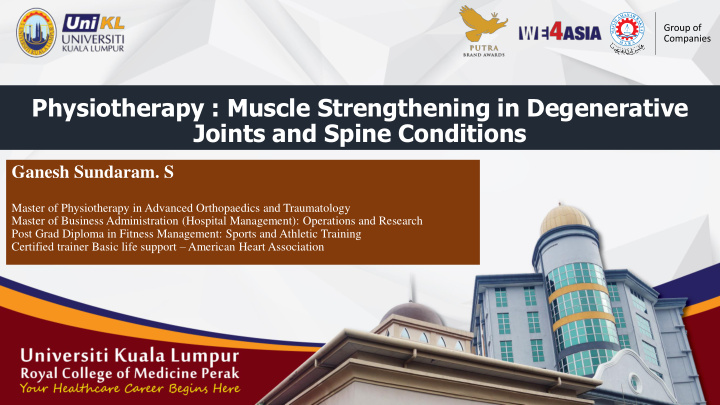



Physiotherapy : Muscle Strengthening in Degenerative Joints and Spine Conditions Ganesh Sundaram. S Master of Physiotherapy in Advanced Orthopaedics and Traumatology Master of Business Administration (Hospital Management): Operations and Research Post Grad Diploma in Fitness Management: Sports and Athletic Training Certified trainer Basic life support – American Heart Association
Degenerative Joint Disease Osteoarthritis (OA), is a common “wear and tear” disease that occurs, when the cartilage that serves as a cushion in the joints deteriorates (AAPMR&R, 2019). This condition can affect any joint but is most common in knees, hands, hips, and spine (AAPMR&R, 2019). https://www.aapmr.org/about-physiatry/conditions-treatments/pain-neuromuscular-medicine-rehabilitation/degenerative-joint-disease
Background Adults age >65 are affected by degenerative joint disease. This condition is associated with pain, loss of function, and reduced endurance, ultimately leading to weight gain and associated complications (AAPMR&R, 2019). The underlying cause of this condition is typically chronic repetitive motion that results in inflammation and structural joint damage. https://www.aapmr.org/about-physiatry/conditions-treatments/pain-neuromuscular-medicine-rehabilitation/degenerative-joint-disease
Signs And Symptoms ▪ Pain during or after movement. ▪ Stiffness might be most noticeable upon awakening or after being inactive. ▪ Tenderness. ▪ Loss of flexibility. ▪ Bone spurs. ▪ Swelling. https://www.aapmr.org/about-physiatry/conditions-treatments/pain-neuromuscular-medicine-rehabilitation/degenerative-joint-disease
Stretching Exercise ▪ Increases your flexibility. ... ▪ Increases your range of motion. . ▪ Improves your performance in physical activities. ... ▪ Increases blood flow to your muscles. ... ▪ Improves your posture. ... https://cellcode.us/quotes/are-muscle-spindles-action-when.html
Proprioceptive Neuromuscular Facilitation This is a rehabilitation technique that used to stimulate the neuromuscular system in an effort to excite proprioceptors (sensory organs in muscles, tendons, bones and joints) in order to produce a desired movement. Four theoretical mechanisms: • Autogenic inhibition • Reciprocal inhibition • Stress relaxation • Gate control theory. It shows potential benefits if performed correctly and consistently. (Hindle, Whitcomb, Briggs, & Hong, 2012)
PNF Techniques HOLD RELAX ▪ Contracting the muscle without moving (also called isometric), such as pushing gently against the stretch without actually moving.
PNF techniques CONTRACT RELAX • It is almost identical to hold-relax, except that instead of contracting the muscle without moving, the muscle is contracted while moving. This is sometimes called isotonic stretching. • For example, in a hamstring stretch, this could mean a trainer provides resistance as an athlete contracts the muscle and pushes the leg down to the floor.
PNF Patterns – Upper And Lower Limb https://www.pinterest.com/kcoxpt/ https://www.cupeli.com/pnf-patterns-upper-extremity/
Muscle Energy Technique https://www.slideshare.net/venus88/met-lecture https://patioyarddesign.com/
Knee Exercises HAMSTRING STRETCH CALF STRETCH
QUADRICEPS SET STRAIGHT LEG RAISE
HEEL RAISE ONE LEG BALANCE
Hip Exercises PELVIC BRIDGING HIP FLEXION EXERCISE
Spine Exercises ABDOMINAL ISOMETRICS KNEE TO CHEST
PELVIC TILT CURL UPS
LYING LATERAL LEG RAISE CAT AND CAMEL
What's Next ?
Aquatic Therapy ▪ WARM WATER : facilitates muscle relaxation and increases peripheral circulation. ▪ VISCOSITY OF WATER : provides resistance for strength training. ▪ THE REDUCTION OF GRAVITATIONAL FORCES . ▪ BUOYANCY : in warm water results in decreased pain sensitivity. ▪ IMPROVEMENT OF PATIENT MORALE. http://hasshe.com/stretching-pool-therapy-ideas-5c148f418719620724bdc5bc/ https://dshealthcare.com/blog/aquatic-therapy-
Question And Answer If you experience pain or discomfort lasting longer than a day, please seek assistance from a Health care professional.
Recommend
More recommend